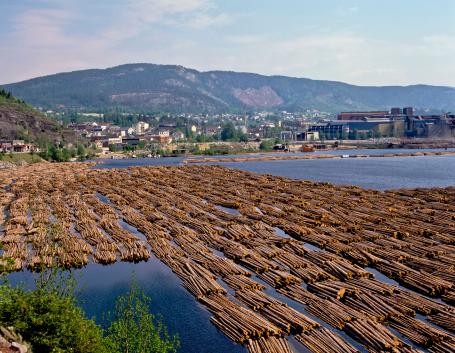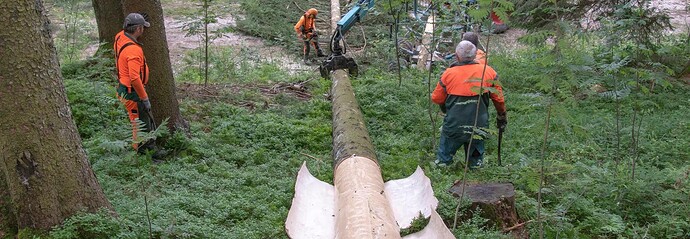Europe’s forests face increasing pressures.
Impacts include fewer tall forests, climate change-induced wildfires, insect outbreaks, and, most recently, increased wood harvesting to meet additional demand for “home-grown” biomass in response to the Ukraine war and changing energy demands.
Against this backdrop, the EU’s proposed Nature Restoration Law would introduce critical safeguards to prevent further decline in the quality of Europe’s forests. The law seeks to protect remaining old-growth forests, set aside additional forests for restoration, and improve the biodiversity of forests managed for wood production.
Here, we look at the latest data, including that from University of Maryland’s GLAD lab and available on WRI’s Global Forest Watch platform, to investigate European forest changes.
1) The Area of Tall Nordic Forests Is Declining.
Over the past two decades, the extent of Europe’s tall forests (forests with trees taller than 15 meters) declined by 2.25 million hectares, an area half the size of Denmark. The Nordic region (Denmark, Finland, Norway and Sweden) saw the biggest declines, losing 3.5% of its total forests and 20% of its tall forests over the last two decades.

Log rafts in Notodenn, Norway. The vast majority of tree cover loss in recent years in Europe can be attributed to human causes like logging. Photo by Rick Strange/Alamy
Tall forests are critical for storing carbon and hosting biodiversity. When an area of tall forest is logged or burnt down, it will often regain tree cover from replanting or natural regeneration. However, the new trees can take decades to grow to the point where they provide the equivalent climate and ecosystem benefits of a mature forest. Ecosystem benefits may never be recovered in cases where only one or two species are planted in place of mature stands with a natural diversity of species.
In Europe, over 80% of tree cover losses between 1986 and 2016 were human-induced, such as harvesting for timber. This proportion is even higher in Northern and Eastern Europe. Disturbance rates remained high in recent years, with Finland and Sweden, Europe’s most-forested countries, losing 1.1% of their tree cover in 2023 (based on the forest extent in 2000). This is higher than the EU average of 0.85%.
2) Using Wood for Energy Is Impacting the EU’s Forests.
Around half of the wood produced in the EU is used for energy, and many countries have been rapidly increasing their use of biomass energy.
For example, Hungary saw a large increase in tree cover in recent decades, suggesting a ready supply of timber for energy. In 2023, Hungary experienced the highest amount of annual tree cover loss since our records began — a 33% surge from 2022, during which time Hungary’s bioenergy production also increased. Due to Russia’s invasion of Ukraine and the EU’s move to significantly reduce the use of Russian gas, Hungary’s government relaxed regulations on wood harvesting, including for domestic energy provision, which may further fuel wood removals.
While Hungary oversees its own forests, it will soon take a lead in forest and other environmental policies in the EU writ large, as the country holds the rotating presidency of the Council of the EU in the second half of 2024. Its leaders will influence the agenda-setting of various Ministerial Council meetings, including those on the environment, agriculture, forestry and climate. While Hungary recently opposed the EU Nature Restoration Law, which would see restoration measures introduced in at least 20% of the EU’s land and sea areas by 2030, the country could end up taking a central role for this key environmental law or postpone it for a future EU presidency. The EU Forest Monitoring Framework, which was proposed by the European Commission in November 2023 and aims to ensure timely information on the health and management of EU forests, is another critical directive slated for consideration in the second half of 2024.
3) Fires Exacerbated by Climate Change Continue to Impact Southern Europe’s Forests.
2023 was a record-breaking year for wildfires in Greece. Fires driven by extreme summer heatwaves accounted for 85% of the tree cover loss in 2023 — the highest proportion of fire-related tree cover loss in the EU. Spain and Portugal had the next highest proportion of loss due to fires in 2023, at 26% and 20%, respectively.

A wildfire rages over the picturesque landscape of southern Spain. Increasing wildfires are nothing new for southern Europe, exacerbated by climate change, heatwaves and more. Cavan Images/Alamy
And last year was not a blip; wildfires have been an ongoing trend in southern Europe in recent years. Climate change, heatwaves and drought, coupled with large plantations of highly flammable non-native species such as Eucalyptus, create ideal conditions for record-breaking fires.
Fires are less prevalent outside of southern Europe, with only 6% of all tree cover loss in the EU due to fires in a relatively wet 2023.
4) Insect Disturbances Are Increasing Due to the Dominance of Spruce Trees and Climate Change.
Europe’s forests have been increasingly affected by insect outbreaks, due to global warming and poor forest management practices. Germany has been particularly impacted, where large areas of planted spruce trees growing in drier, warmer conditions are increasingly vulnerable to bark beetle infestations. Such infestations weaken and kill growing numbers of trees.
For example, timber harvesting rates in Germany reportedly decreased by 10% from 2022 to 2023, but satellite data shows a 42% increase in tree cover loss within the same period, suggesting the loss was not related to harvesting. In the state of Thüringen, which lost the most tree cover in Germany from 2022 to 2023, high rates of insect disturbances in spruce were reported.
New EU Laws Must Lead to Better Managed Forests
Europe’s forests face mounting threats, but if implemented and designed well, emerging regulations could improve the situation within a decade.

Logging trucks remove timber in Estonia’s forest. This new framework would require EU member states to be more transparent with regard to their forests and commodities. Photo by Karl Ander Adami/Alamy
For example, the EU’s Nature Restoration Law intends to improve the protection and restoration of the region’s forests by increasing carbon stocks and the age and diversity of tree species, but it is still awaiting approval from the European Council. The proposed Forest Monitoring Framework would require EU Member States to provide detailed, robust and timely information on the condition and health of their forests, as well as long-term plans for forest maintenance. And the EU Deforestation Regulation, which will come into effect on December 30, 2024, states that wood supplied from within the EU should not lead to forest degradation.
These regulations are essential, enabling the EU to preserve what’s left of its mature and most valuable forests for climate and nature, while still supplying timber and energy for people.
Source: What's Driving Europe's Forest Loss? | World Resources Institute
